
14 minute read
Novel Lithium Free Thickener System
Novel Lithium Free Thickener System: Performance Profile, Characteristics and Target Applications
Dwaine Morris, Shell Global Solutions (US), Inc.
New High-Performance Grease Technology
For the last 80 years, lithium has been the dominant thickener technology for lubricating greases. In fact, globally lithium and lithium complex greases account for approximately 70-75% of all grease production [1]. Lithium based greases have been persistent due their versatility, frictional properties, and costeffectiveness. However, simple lithium greases have limited operational temperature ranges. Lithium complex greases address most of these shortcomings, but equipment design and customer expectations regarding performance are challenging the ability of these greases to meet customer needs.
In an ironic twist, when lithium-based greases entered the market, promising work on lithium alternatives was halted. Now that industry is seeing increased cost of goods pressures from non-grease related lithium demand, it is forced to evaluate alternatives that were potentially abandoned in the past.
Demand for lithium has increased due to competitive applications such as batteries [2] (Figures 1 and 2). These alternative demands have the potential to erode the cost-effectiveness of lithium-based greases [3].
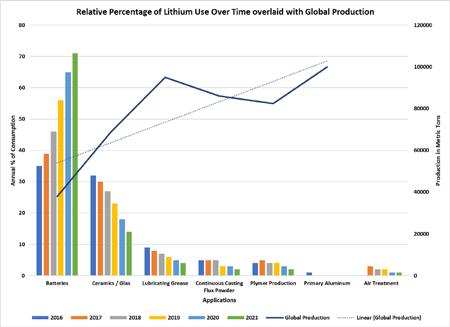
$18,000
$16,000
$14,000
$12,000
Metric Ton Price ($)
$10,000
$8,000
$6,000 100000
80000
60000
40000 Metric Tons of Production
$4,000
$2,000 20000
$0
2014 2015 2016 2017 2018 2019 2020 2021 Year
Metric Ton Price Production Linear (Metric Ton Price) Linear (Production)
Figure 2 Lithium production and price changes over time
0
Alternative grease technologies are available but have not gained significantly in market share and have their own limitations. As industry increases its focus on sustainability and carbon intensity, the search for effective, high-performance alternatives to lithium-based greases has accelerated. A new class of greases, not dependent on lithium or other raw materials that have handling challenges would be primed to displace lithium, providing a versatile, high-performance alternative for industrial and transport applications. A novel thickener system (NTS) has been developed that can be manufactured in existing production vessels / production lines. This thickener system has demonstrated unique properties and is a promising alternative thickener system that could compete to replace significant lithium-based volumes and provide performance advantages.
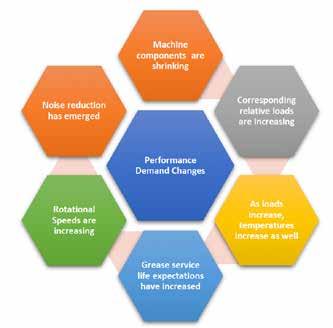
Figure 3 Industrial change drivers and trends
Innovation Drivers
In an effort to reduce weight and increase efficiency, many OEMs are designing smaller components. As equipment shrinks, relative loads are increasing, corresponding to increasing operational temperatures. This impacts performance additive choice, base oil selection and lubrication service intervals. Fill-for-life applications are increasing in number and are pushing the limits of standard greases to meet customer expectations (Figure 3).
It is becoming increasingly more obvious that reliance on 80-year-old technology is tenuous at best. As industry focuses on efficiency / reduction of lost work, new technologies are needed. For a world in motion, this is a needed upgrade.
Formulary Insight
A new, patented grease thickener system has been created that enables high-performance, long service life lubricating greases with enhanced frictional properties that increase bearing efficiency. The novel thickener system is a lithium-free, complex grease that incorporates calcium into the thickener matrix. It utilizes a unique blend of acids and method of manufacture that imparts exceptional properties that enable classleading performance advantages.
Greases formulated with this thickener system have dropping points that exceed that of complexed lithium greases and in line with calcium sulfonate complex greases (250°C to 300°C). The thickener system forms a very thick, tenacious film that can be detected in a bearing running track post-durability testing (SKF R0F). In that test, the grease is subjected to high shear and normal / light loading. There is no re-lubrication of the test bearings, and they are run to failure.
R0F Test Conditions[4]: Bearing Type Deep Groove Ball Bearing (6204-2Z/C3) (5 sets of two) Grease volume fill Normal (1.4 grams) Speed Variable from 5600 to 20,000 RPM (10,000 RPM is standard) Load 100N axial / 50 N Radial
In the standard test, a L50 life in excess of 1000 hours is the target based on a Weibull distribution of the test bearing set.
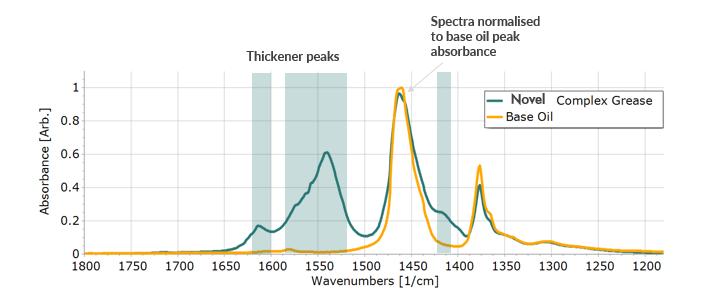
In the graphic (Figure 4) the yellow Fourier transform infra-red (FTIR) trace indicates the base oil spectrum of a grease formulated with the novel thickener system. The green trace, also highlighted in green boxes indicate the FTIR spectrum of a fully formulated grease manufactured with the new thickener system taken from the running track of a post-test R0F bearing. Why this is so significant is that while it has been known that grease thickeners contribute to the bearing raceway films, the extent to which that happens varies from one thickener technology to the other. The normalized intensity of the thickener peaks demonstrates how significant the contribution is relative to that of the base oil (yellow trace).
Performance Profile
Greases manufactured with the NTS are very mechanically stable (even in the presence of excess water), oxidative and water resistant, and have excellent load carrying capacity. The long mechanical service life means that it is well suited for fill-for-life applications. Water resistance makes these greases ideal for use where there is potential for water washout or ingression into the application (steel manufacturing, pulp and paper, or over the road transport). When the heat is on and oxidation is a concern, this thickener system has similar performance as polyureas.
Full-size production batches have excellent performance. Figure 5 is a tabular comparison of production batch averages versus performance of a high-quality lithium grease.
Performance Parameter Conditions Method
Dropping point (°C) Penetration worked (0.1mm) Oil Separation (%m) Oil Separation (%m)
Shell Roll (0.1mm)
Four Ball Weld Load (kgf)
Four Ball Wear Test scar diameter (mm)
Copper Corrosion (-) Emcor rust test (-) Emcor rust test (-) Timken OK Value (lbs) Water Washout (%m) Water spray off (%m)
FAG FE-9 (h)
Oxidation stability (kPa) IP396 25°C ASTM D217 18h @ 40°C IP 121 168h @ 40°C IP 121 18h, 65°C +10% water ASTM D1831
ASTM D2596
40kg; 1h; 75°C; 1200rpm ASTM D2266
24h @ 100°C ASTM D4048 distilled water ASTM D6138
SSW ASTM D6138 ASTM D2509 1h @ 79°C ASTM D1264 5min at 38°C ASTM D4049
L50-6000 rpm/1500N, 140°C
L50-6000 rpm/1500N, 130°C DIN 51821
100h @ 99°C ASTM D942 Mineral ISO 320 NTS Running Avg of Production Size Batches 295 335 0.3 1
52
400
0.44
1b max 0/0 1/2 60 2 24
170
29.0 Mineral ISO 220 Li, EP
Typical Values
>180 285 1.6 3.5
70
315
0.6
1b max 0/0 2/3 50 4 30
200
28
Figure 5 Performance testing results for full-size production batches versus an ISO 220 mineral Lithium based grease for context
Why is the NTS different?
There are three specific areas where grease manufactured with this thickener system are different: • Versatility in film formation and contribution • Non-traditional frictional performance • Friction performance on ‘rough’ surfaces
Formulary Versatility
Using base oil selection to manage film thickness is possible with this thickener system, opening the potential to produce greases that have a thicker film within ISO viscosity grades (compared to lithium for
example) and could facilitate the use of lower viscosity base oils that have an impact on friction, lost work, and other key parameters depending on the application.
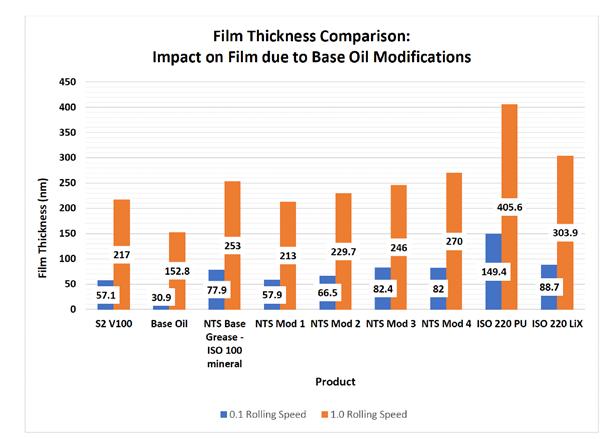
Figure 6 Impact of base oil variation on film thickness
The relative film thickness of ISO 100 greases, produced with the novel thickener system, as base oil modifications are made is illustrated in Figure 6. These were measured using a ball-on-disc tribometer (PCS Instruments) with pure rolling contact. The temperature was 40oC and the test was run at speeds from 10 to 1000 mm/s (0.01 to 1 m/s). The results in figure 4 are those measured at 0.1 and 1 m/s. The film thickness of a standard lithium grease and the base oil that is used to manufacture it are in the first two sets of bars. The base ISO 100 mineral grade grease manufactured with the novel thickener system (NTS) is the next set of bars. Each of the next four sets of successive bars are a 15% base oil substitution of the base grease, illustrating the effect on film thickness that can be achieved with a minority base oil substitution. For context, the last two sets of bars are for ISO 220 Polyurea (Di-urea) and lithium complex greases. It has been well understood that PU greases provide a very thick film at low linear speeds [5,6]. This work aligns with these previous findings. What is important to note is that an ISO 100 grease manufactured with NTS produces nearly the same film thickness as that of an ISO 220 lithium complex.
It is possible to achieve a fluid film thickness that is 24% thicker than the lithium-based ISO 100 grease. The same grease has a measured film thickness that is only 10% thinner than an ISO 220 lithium complex grease (the last set of bars). The implication is that you can reduce viscosity and still have a film thick enough to adequately protect the components.
These results suggest that one may begin to evaluate greases with base fluid viscosity at least one ISO grade lower capable of providing sufficient component protection and provide efficiency gains, reducing lost work. This is potentially very interesting for industrial electric motor and electric vehicle applications.
produced being consumed by electric motors, a 1% overall efficiency gain can remove tons of carbon dioxide while accomplishing the same amount of work. In the case of EV, range impacts are being explored.
Frictional Performance
Beyond the ability to reduce viscosities, the properties of the grease itself are unique with respect to frictional performance. Bearing manufacturers place operational temperature limits based on torque at start up. Industry accepted values (as indicated by bearing manufacturers such as SKF 4) are suggested based on the ability of a lubricating grease to ‘bleed’ oil from the grease structure into the bearing contact. This bleed rate decreases with decreasing temperature. At the same time, the apparent viscosity of the grease increases, further increasing torque values. SKF calls this the Low Temperature Limit for the test grease. This varies from one grease to another and can be significantly different depending on which thickener technology is utilized to reach the desired NLGI consistency (thickener content can vary widely to achieve the same NLGI consistency). The general rule is that maximum, starting torque, should not exceed 1,000 mNm (or 1Nm) at the ambient start up temperature. The ASTM D1478 / IP 186 test is the method used to measure this maximum torque.
In the graph below (Figure 7), the first four sets of bars are the measured low-temperature torque results in this test for market available, dedicated electric motor greases. On average, the starting torque is over 4,500 mNm at -40°C. This is considered extremely cold. With these results, none of the market greases would be suitable for intermittent operation in climates where the ambient temperatures reach -40°C / -40°F. Under these ambient conditions, it would be advised to utilize a synthetic grease to reach the recommended torque requirements.
A mineral oil (Group I/II blend) NTS grease of the same ISO grade has drastically lower torque in the same test- by greater than 50% (the 5th set of results). Compare that to the remaining sets of bars that are the results from synthetic ISO 100 greases. The frictional performance of the NTS grease approaches the performance of a synthetic, while utilizing a mineral oil base stock
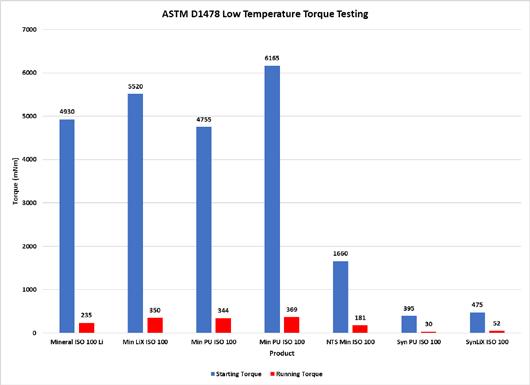
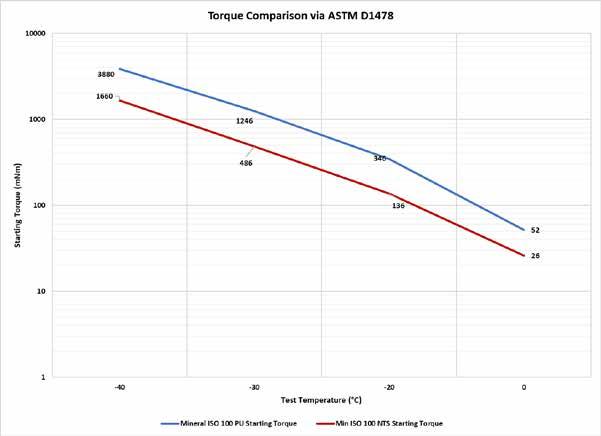
Figure 8 Torque response as ambient test temperature increases
Figure 9 Traction coefficient versus liner speed for various greases
What is even more significant is that this torque gap is consistent, even when starting ambient temperature increases (Figure 8). The effect does not shrink as those temperatures increase. The gap persists and averages ~57%. This is illustrated in the gap between the red and blue lines. The implications on bearing efficiency are significant- regardless of if we are considering industrial or EV/transport bearings.
As industry looks to performance in ultra-high-speed bearings, such as those in electric vehicle applications, grease manufactured with this thickener system can enable efficient bearing operation, offering reduced friction and viscosity for the application. Consider the graphic below:
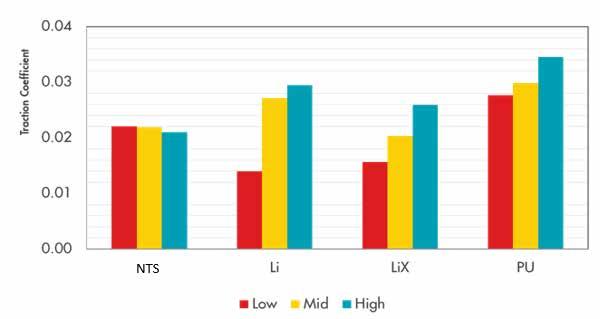
The graph (Figure 9) indicates the friction properties of the test grease as speeds increase in the contact. This data was measured using the mini traction machine (MTM – PCS Instruments). It was run with 5% slide-roll ratio at 40oC. A grease scoop was used to maintain mostly fully flooded conditions. The red bars indicate 10 mm/s liner speed, while the yellow indicates 100 mm/s and the blue bars indicate 1000 mm/s. The frictional response from representative Li, LiX and PU thickened greases respond as anticipated, as linear speed increases, friction increases. However, the grease manufactured with this innovative thickener system exhibits no increase in friction as speeds increase over two orders of magnitude. This is unique behavior that needs to be understood and leveraged to reduce lost work.
Lastly, surface roughness versus frictional behavior of greases manufactured with this thickener system show performance advantages as well. Required viscosity is a function of surface roughness, speed and operating temperature. Bearing OEMs have proprietary software or equations that, based on their bearing finishes, predict the required viscosity of an oil or grease necessary to provide adequate lubrication. The surface finish comes at a manufacturing cost that ends up in the final cost to the bearing consumer. The NTS greases illustrate frictional performance has been tested on very smooth to ‘normal’ rough surfaces. When compared to standard lithium, lithium complex and polyurea greases this technology exhibits ‘non-standard’ behavior where friction does not increase with surface roughness, but actually declines slightly. Again, this behavior needs to be verified and understood before true impacts can be projected.
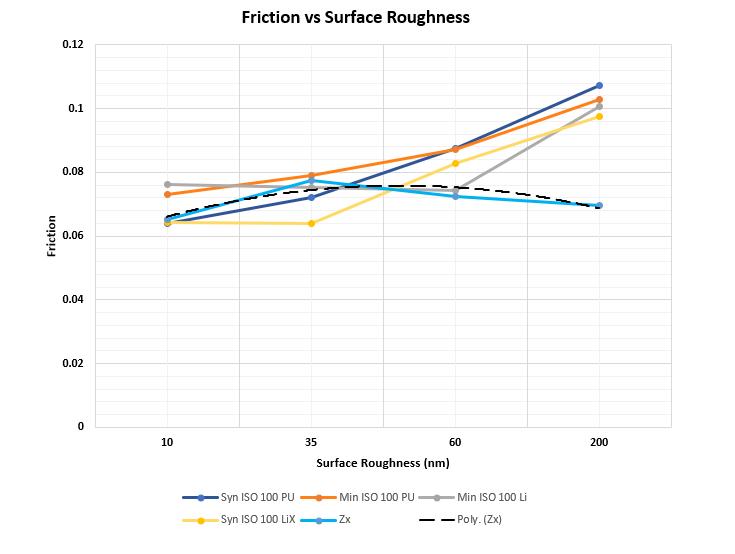
Figure 10 Frictional performance of greases on surfaces of different mean roughness
This data (Figure 10) was generated in a ball on disk tribometer where the surfaces were polished to different average surface roughness. The standard greases illustrate increasing friction as surface roughness increases. Lubricating greases manufactured with NTS behave differently where friction stays essentially flat.
When paired with the speed independent friction illustrated earlier, this is the final, remarkable property of this thickener system. In large industrial bearings, the surface finishing costs escalate with size. The finer the surface, the more costly. By being able to achieve low frictional performance across a wide speed range, the bearing OEMs could find relief from those added costs- directionally making them less costly to the consumer in the end without increasing the viscosity required to lubricate them. And, when viscosity is low, the bearings can run more efficiently.
Why does this matter?
The performance implications of these unique physical properties are ground-breaking. The thicker, tribologically active film enables reduced base fluid viscosities that enable bearing efficiency without sacrificing reliability and component protection. The unique frictional properties of the thickener enable the use of this technology in electric motor (and EV) applications providing constant low friction as speeds vary, again reducing lost work in the bearing.
The payoff is significant with the reduction of lost work relative to sustainability goals. The incremental efficiency gains across a facility (or vehicle) that contains thousands of electric motors can provide a tremendous, aggregated benefit. When one combines the effects of low viscosity, synthetic base fluids and the thickener behavior, the reduction of carbon dioxide emissions across the industry and transport sectors can provide significant benefits as industry strives toward a more sustainable future.
1 National Lubricating Grease Institute Annual Production Survey (2019) 2 Lithium Data Sheet- Mineral Commodity Summaries, US Geological Survey, (2016-2022) 3 Lithium Data Sheet – Mineral Commodity Summaries, US Geological Survey, (2016-2022) 4 “Grease Lubrication in Rolling Bearings”, Lugt, P. (2013) 5 Cann PM, “Grease Lubrication in Rolling Element Bearings – Role of Grease Thickener.”, Lubrication Science, 19:183-196 (2007) 6 Di Laurentis N, Kadiric A, Lugt P, Cann PM, “The Influence of Bearing Grease Composition on Friction in Rolling / Sliding Concentrated Contacts.”, Tribology International, 94: 624-632 (2016)
NLGI Women in Grease
Interest Network is committed to educating, promoting, advancing, and sustaining industry experts in the lubricating grease industry while emphasizing the need for diversity in management and leadership. This is accomplished by connecting professionals within the industry through networking events, educational workshops and philanthropic endeavors.
open to All members!
Contact nlgi@nlgi.org to join the distribution list. Details on inaugural virtual event coming soon.







